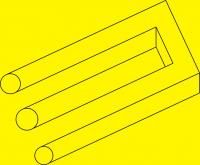G0 velocity limitation
For example on my Bridgeport mill Y is the slowest axis because it has the most weight to move. Z has the least mass of the three axes. I would like to Z to not be limited to the max velocity of the Y axis.
I find that jogs do not suffer this limitation. The axis will move at its respective programmed max velocity.
Please Log in or Create an account to join the conversation.
i was lead to believe that as long as the slow axis move was short or not used it wouldn't negatively effect the other speeds.
what surprises me is that the y has more inertia than the x. i know there is more mass but it also has a lot less leadscrew and if you left the hand wheels installed that's a fair amount of inertia as well. i don't think people take that into account but it makes a difference. and i wouldn't think you'd see a difference between x and y.
what do you use for motors? leadscrews? lube?
Please Log in or Create an account to join the conversation.
In my case my the Y axis has the most mass and has the lowest velocity. The Z axis (the spindle) has the least mass and consequently should be the fastest is thereby limited in its speed on a G0 call. When one is drilling with pecking for deep holes, it is obvious that with all the rapid calls it moves as fast as achievable. I hope we can find a solution to our problem. I find that on jogs each axis moves at its programmed max rate.
jensor
Please Log in or Create an account to join the conversation.
Is it possible to configure system so that on a G0 call the velocity on the moving axis will move at its programmed max velocity instead of being limited to the slowest axis?
For example on my Bridgeport mill Y is the slowest axis because it has the most weight to move. Z has the least mass of the three axes. I would like to Z to not be limited to the max velocity of the Y axis.
I find that jogs do not suffer this limitation. The axis will move at its respective programmed max velocity.
Do you mean when moving only 1 axis at a time?
On my machine I have different MAX_VELOCITY for each axis. a G0X0 will rapid at the speed defined in each [AXIS_N] section
Check your [TRAJ] MAX_LINEAR_VELOCITY, is is set lower than any of the axes? I would guess not, as it should limit all axes to that limit, but worth a shot.
If you were talking about rapid moves that involve more than 1 axis, then It will limit the speed so that all axes reach the end at the same time.
Please Log in or Create an account to join the conversation.
I hope I can find a solution to this limitation.
My setup is on a Bridgeport milling macine and I wanted faster movement on z for peck drilling.
jensor
Please Log in or Create an account to join the conversation.
if you want to do x,y,z similtanious moves without being limited by the slow axis and z can go 500ipm and the x can go 200ipm and y goes 150 and the z travel is 5in then the x can maybe go 2 inches and y 1.5 in the time it takes for the z to travel its range depending on acceleration.. if you find the diagonal of that rectangular box and you'd have the maximum velocity that could be achieved which is somewhere around 560ipm for this example that the MAX_LINEAR_VELOCITY could never slow the machine. the formula is similar to the Pythagorean theorem. diagonal=sqrt(L^2+W^2+H^2)
also my numbers i ran for figuring my motor requirements suggest the x would have the most inertia despite the y having more mass becasue the rotational inertia of the longer leadscrew and extra handwheel is pretty significant. the y may have more frictional drag but with lubrication it shouldn't be much at all.
Please Log in or Create an account to join the conversation.
Yes, I mean specifically moving a single axis such as G0 Z-4. I find even though Z max vel is set to 1.5 (90 ipm) it will only move on the g0 call at .6 (36 ipm) which is the max vel programmed in for the Y axis.
Well that just seems wrong.
On one of the knee mills we have power to the the table (W axis) it moves quite slow however it only effects the other axis when in combined moves.
A g0 move of only 1 axis should move at it's max speed and not be effected by any other axis.
As pointed out above I would reset the MAX_LINEAR_VELOCITY higher.
Also check your ini for errors / duplicate entries.
Rick G
Please Log in or Create an account to join the conversation.
I ran into this when I was simulating to see how mine acted, took a few minutes to figure out why my changes weren't working.
Please Log in or Create an account to join the conversation.
The default values in the downloaded files were all the same, 1.2 (72 ipm). I made the following changes:
[TRAJ] section MAX_VELOCITY = 3 (180 ipm) (Just to be sure that doesn't get in the way and it shouldn't anyway on single axis moves)
[AXIS_0] (X axis) Max vel to .6 (36 ipm)
[AXIS_1] (Y axis) to .4 (24 ipm)
[AXIS_2] (Z axis) to 1.0 (60 ipm)
When running the program each axis jogged at its programmed max rate. However on a G0 single axis command things were quite different:
G0 X2 moved at 36 ipm (same as its programmed rate)
G0 Y2 moved at 24 ipm (same as its programmed rate)
G0 Z2 moved at 36 ipm (limited to X's programmed rate - not the slowest axis)
I then increased the max vel for the X axis in the ini file to 1.2 (72 ipm)
and then found that the Z axis would move at its programmed rate of 60 ipm!
All axes would g0 at their programmed max vel rates!
So a work around for this problem would be to configure the fastest axis (in my case the Z axis) as [AXIS_0].
jensor
Please Log in or Create an account to join the conversation.
AXIS_0 MAX_VELOCITY = .6
AXIS_1 MAX_VELOCITY = .4
AXIS_2 MAX_VELOCITY = 1.0
Then I started up and homed, and issued MDI commands:
G0X1 - expected the DRO to say Vel: 36, and it did
G0Y1 - expected the DRO to say Vel: 24, and it did
G0Z-1 - expected the DRO to say Vel: 60, and it did
Can you reproduce this in sim? Please say every step you are doing, along with the settings of your feed override, jog speed, and max velocity sliders.
Please Log in or Create an account to join the conversation.



